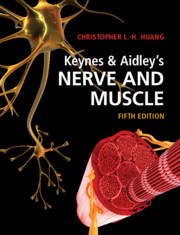Book contents
- Keynes & Aidley’s Nerve and Muscle
- Keynes & Aidley’s Nerve and Muscle
- Copyright page
- Dedication
- Contents
- Preface
- Acknowledgements
- Abbreviations used in the text
- 1 Structural Organisation of the Nervous System
- 2 Resting and Action Potentials
- 3 Background Ionic Homeostasis of Excitable Cells
- 4 Membrane Permeability Changes During Excitation
- 5 Voltage-Gated Ion Channels
- 6 Cable Theory and Saltatory Conduction
- 7 Neuromuscular Transmission
- 8 Synaptic Transmission in the Nervous System
- 9 The Mechanism of Contraction in Skeletal Muscle
- 10 The Activation of Skeletal Muscle
- 11 Excitation–Contraction Coupling in Skeletal Muscle
- 12 Contractile Function in Skeletal Muscle
- 13 Cardiac Muscle
- 14 Ion Channel Function and Cardiac Arrhythmogenesis
- 15 Smooth Muscle
- Further Reading
- References
- Index
7 - Neuromuscular Transmission
Published online by Cambridge University Press: 07 November 2020
- Keynes & Aidley’s Nerve and Muscle
- Keynes & Aidley’s Nerve and Muscle
- Copyright page
- Dedication
- Contents
- Preface
- Acknowledgements
- Abbreviations used in the text
- 1 Structural Organisation of the Nervous System
- 2 Resting and Action Potentials
- 3 Background Ionic Homeostasis of Excitable Cells
- 4 Membrane Permeability Changes During Excitation
- 5 Voltage-Gated Ion Channels
- 6 Cable Theory and Saltatory Conduction
- 7 Neuromuscular Transmission
- 8 Synaptic Transmission in the Nervous System
- 9 The Mechanism of Contraction in Skeletal Muscle
- 10 The Activation of Skeletal Muscle
- 11 Excitation–Contraction Coupling in Skeletal Muscle
- 12 Contractile Function in Skeletal Muscle
- 13 Cardiac Muscle
- 14 Ion Channel Function and Cardiac Arrhythmogenesis
- 15 Smooth Muscle
- Further Reading
- References
- Index
Summary
Numerous terminal branches of motor nerves each end on individual component muscle fibres making up their motor unit. Each ramification terminates in a neuromuscular junction comprising pre- and postsynaptic membranes separated by the synaptic cleft. The neurotransmitter acetylcholine is released in response to depolarisation from presynaptic vesicles as discrete quanta. Each such event elicits a postsynaptic miniature endplate potential. This probabilistic release process follows a Poisson distribution whose probability increases with presynaptic depolarisation. The released acetylcholine diffuses across the synaptic gap to access postsynaptic ACh receptors, proteins each comprising five transmembrane subunits surrounding a central pore. Two of these (α) subunits each include an ACh binding site. ACh binding to both sites causes pore opening, permitting Na+ and K+ permeation, generating endplate currents demonstrable under voltage clamp. The resulting endplate potentials trigger a propagated action potential in the innervated muscle fibre when the resulting depolarisation attains the Na+ channel threshold.
Keywords
- Type
- Chapter
- Information
- Keynes & Aidley's Nerve and Muscle , pp. 88 - 105Publisher: Cambridge University PressPrint publication year: 2020

